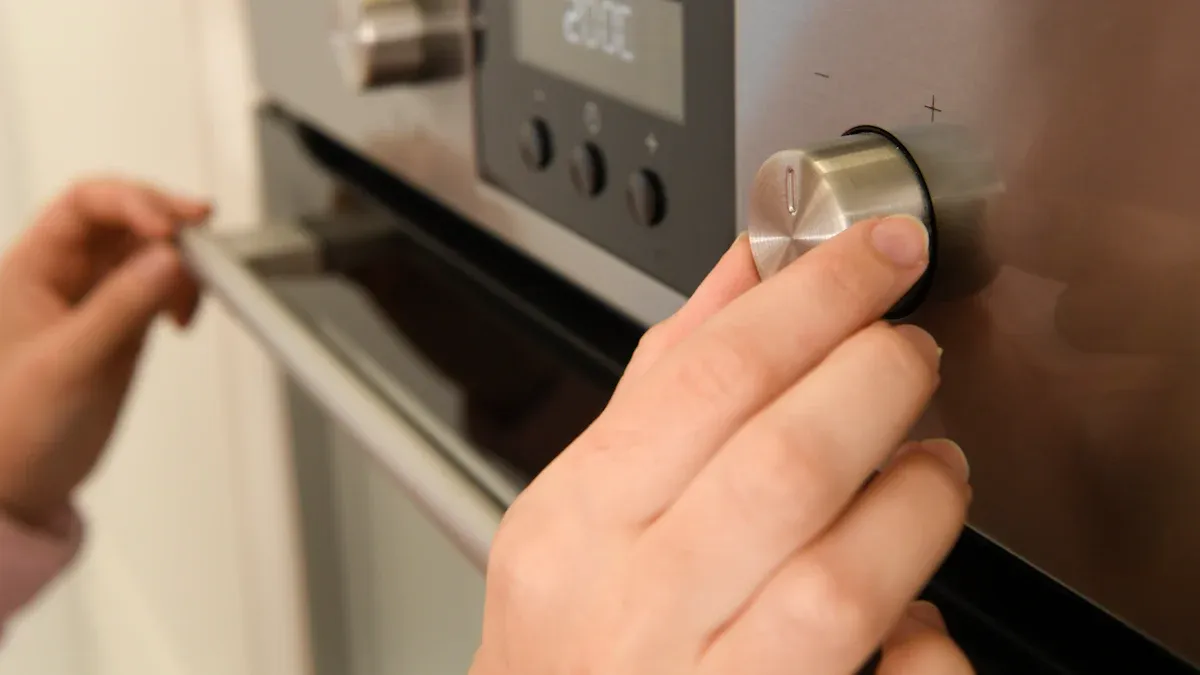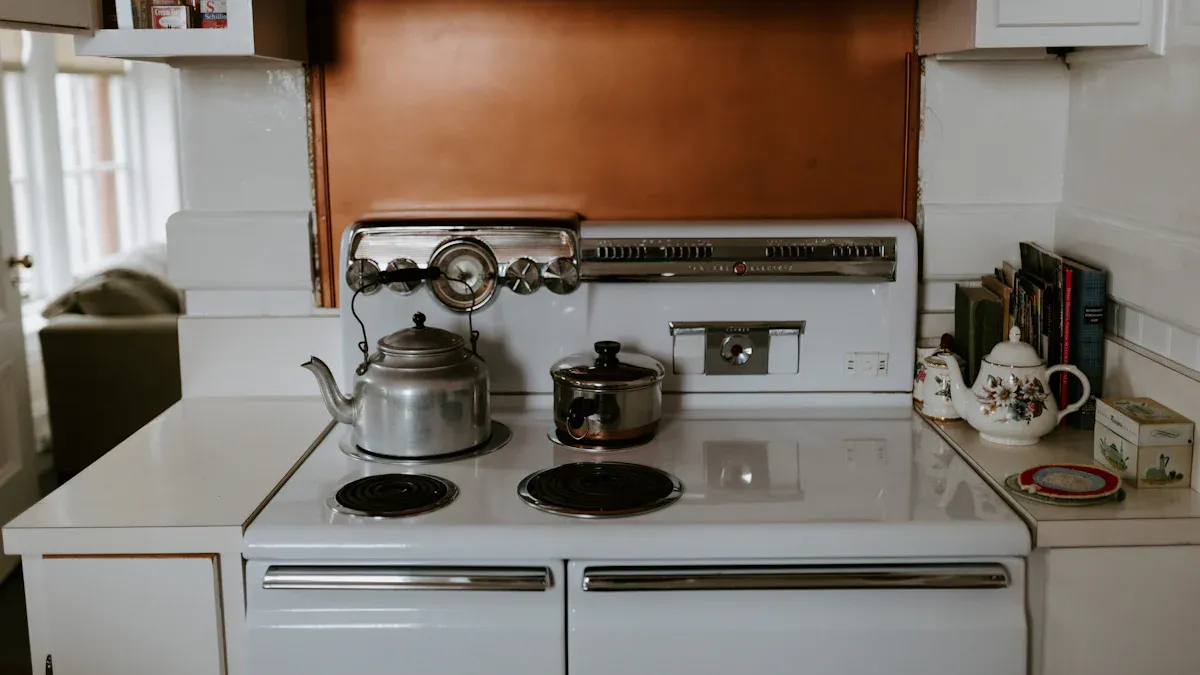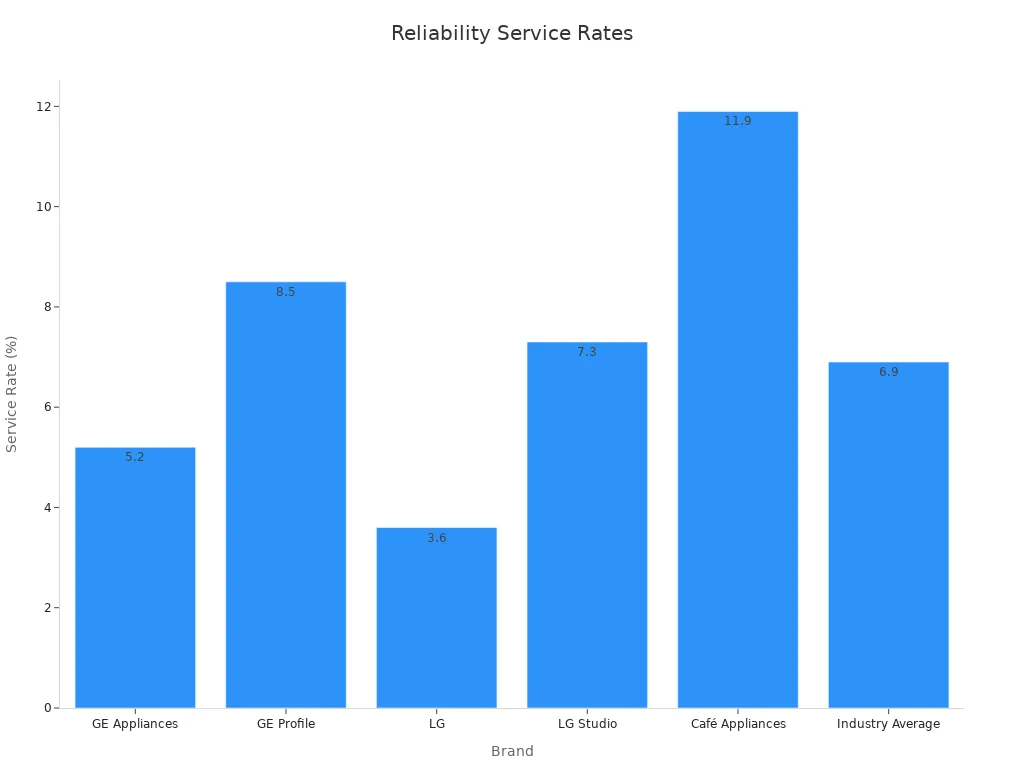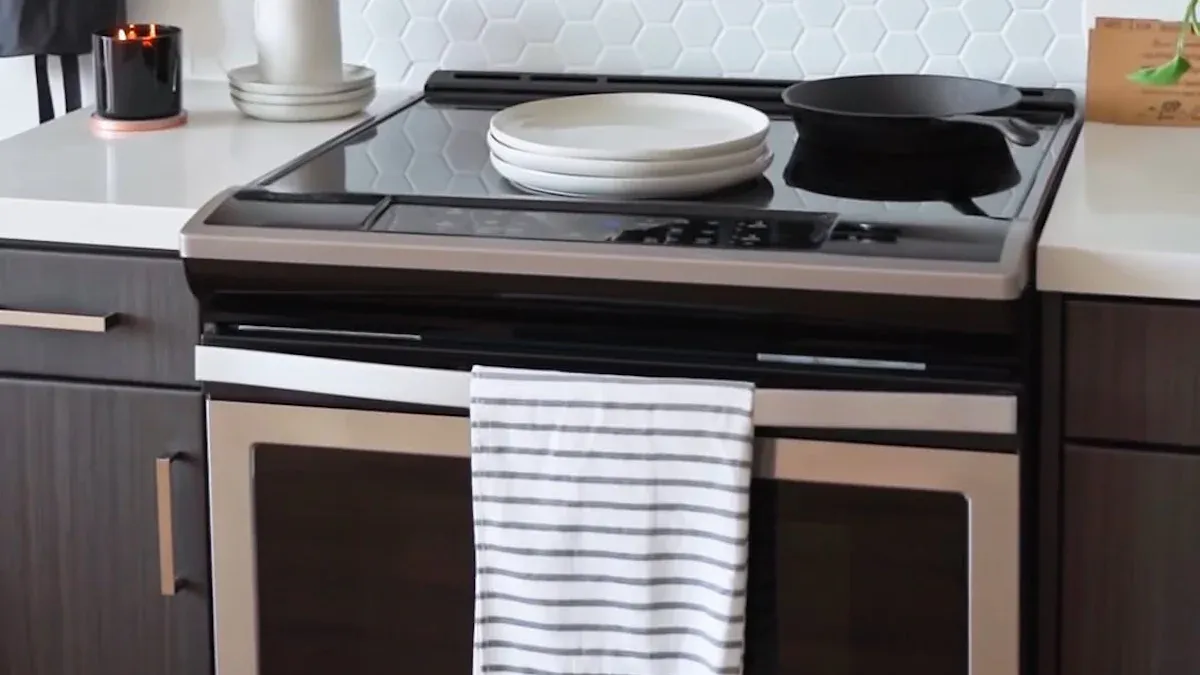
GE stands out as the top recommended brand for most kitchens when selecting a heating coil in oven. This brand consistently delivers reliable performance, broad compatibility with leading oven models, and strong value for homeowners. Choosing the right heating coil in oven ensures efficient heat transfer and minimizes energy loss. The following table shows how coil design impacts both cooking performance and safety:
| パラメータ | Observation/Value | Impact on Cooking Performance and Safety |
|---|---|---|
| Heating coil pitch | Decreasing pitch increases coil and glass temps | Higher temperatures improve cooking efficiency but may affect thermal stability |
| Heat loss | Approximately 10% heat loss observed | Affects energy efficiency and temperature control |
Selecting a high-quality 電熱線 または 加熱管, such as a GE oven heating element, helps maintain safe pan temperatures and reduces ignition risk. Proper oven coil selection supports consistent results and safer cooking experiences.
Key Factors to Consider When Choosing a Heating Coil in Oven Brand
Selecting the right heating coil in oven brand requires careful evaluation of several technical and practical factors. Each aspect directly influences the performance, safety, and longevity of the range in a modern kitchen.
Durability and Lifespan
素材品質
Material quality determines how well heating elements withstand daily use in an electric range or gas range. Manufacturers often use nickel-chromium alloys for their resistance to oxidation and high temperatures. Coatings applied to these elements protect against corrosion and extend service life. Industry-standard tests, such as ASTM B117 and ISO 9227, expose heating coils to a 5% sodium chloride solution at 35°C and high humidity for up to 17,500 hours. These tests measure how coatings and materials resist corrosion over time. Although these tests do not capture every real-world variable, they provide a reliable benchmark for comparing the resilience of different brands.
Resistance to Wear and Tear
Heating coils in ovens face repeated cycles of heating and cooling. This constant expansion and contraction can cause fatigue in the metal. Brands that use high-grade alloys and advanced manufacturing processes produce elements that resist cracking and warping. Over time, resistance to wear and tear ensures the range continues to deliver consistent performance, reducing the need for frequent replacements.
Heating Efficiency
Even Heat Distribution
Efficient heating elements promote even cooking and prevent hotspots. Laboratory tests measure the temperature difference between the center and a 10 cm radius on pan bottoms at 350°F. Lower temperature deltas indicate better heat distribution. For example, a pan with a 23.5°F delta demonstrates superior performance compared to one with a 119°F delta. Even heat distribution is essential for glass top elements and smooth top ranges, as it helps avoid uneven cooking and protects cookware coatings.
| Pan Model | Temperature Delta (°F) | Performance Rating |
|---|---|---|
| Paderno World Cuisine 11″ Paella | 23.5 | 高い |
| Zwilling J.A. Henckels 12″ Skillet | 119 | 低い |
エネルギー消費
Brands design modern heating coils to maximize energy transfer and minimize heat loss. Efficient elements reduce the overall energy consumption of the electric range or kitchen range. Lower heat loss not only saves on utility bills but also helps maintain precise temperature control, which is vital for baking and roasting.
Compatibility with Oven Models
Fit for Popular Oven Brands (GE, Whirlpool, Samsung, LG, Frigidaire, KitchenAid, Electrolux, Thermador)
Compatibility remains a top priority when selecting a heating coil in oven. Leading kitchen range brands, such as GE, Whirlpool, Samsung, LG, Frigidaire, KitchenAid, Electrolux, and Thermador, each have unique design specifications. Some brands offer universal elements, while others require model-specific parts. Ensuring a proper fit prevents installation issues and guarantees optimal performance.
Universal vs. Model-Specific Heating Coil in Oven
Universal heating coils fit a wide range of electric range and smooth top models. These elements offer convenience and flexibility, especially for households with multiple kitchen range types. However, model-specific coils often provide a better fit and enhanced performance for a particular oven or range. Choosing between universal and model-specific elements depends on the user’s needs, the age of the appliance, and the desired level of performance.
Tip: Always check the manufacturer’s compatibility chart before purchasing replacement elements for your oven or range. This step helps avoid costly mistakes and ensures safe operation.
A careful review of these factors helps homeowners select the best heating coil in oven brand for their kitchen range, whether they use a gas range, electric range, or smooth top model. The right choice supports even cooking, energy efficiency, and long-term reliability.
Price and Value
初期費用
When selecting a heating coil for an oven, homeowners often compare the initial price among different brands. The upfront cost can vary based on the material quality, compatibility with the range, and the reputation of the brand. Premium brands may charge more for their heating elements, but these products often feature advanced materials and engineering that justify the investment. Lower-priced options might appeal to budget-conscious buyers, but these coils sometimes lack the durability or efficiency found in higher-end models.
A direct comparison of upfront costs should also consider the fit with the existing range. Some universal coils offer a lower entry price, but model-specific coils from a reputable brand can provide a better match for the oven, reducing the risk of installation issues or early failure. Homeowners should weigh the initial expense against the potential for longer service life and improved performance.
長期貯蓄
The true value of a heating coil in an oven extends beyond the purchase price. High-quality coils from a trusted brand can deliver significant long-term savings by reducing energy consumption and minimizing the need for replacements. Efficient heating elements help the range maintain stable temperatures, which leads to lower utility bills and better cooking results.
A cost-benefit analysis of modern oven heating coils reveals impressive savings over time. The following table summarizes key metrics related to environmental impact and household savings:
| メートル | Result Range / Value |
|---|---|
| Environmental impact reduction | 9% to 62% lower than conventional ovens |
| Life cycle cost savings | 25% to 61% reduction |
| CO2 equivalent savings in EU28 | 0.5 to 5.2 million tonnes per year |
| Annual life cycle cost savings in EU28 | €0.5 to €1.96 billion |
| Household energy consumption reduction | Up to 30% |
| Household consumer cost savings | 25% to 50% |
These figures highlight the substantial benefits of choosing a high-efficiency heating coil for the oven. Over the lifespan of the range, homeowners can expect to save on both energy and replacement costs. The environmental advantages also support a more sustainable kitchen.
Note: Investing in a quality heating coil from a reputable brand can lead to lower total ownership costs and a reduced carbon footprint for the household.
Warranty and Customer Support
保証範囲
Warranty coverage plays a critical role in the overall value of a heating coil for an oven. Leading brands typically offer warranties that protect against manufacturing defects and premature failure. The length and terms of these warranties can vary, but most reputable brands provide coverage that aligns with industry standards. A strong warranty signals the manufacturer’s confidence in the product and offers peace of mind to the homeowner.
Statistical data from the appliance and HVAC industry demonstrates the effectiveness of warranty management in the heating coil segment. The table below presents recent industry figures:
| メートル | Appliance & HVAC Industry (2003-2023) | Appliance & HVAC Industry (2023) | Notable Manufacturers (2023 Claims Paid in $M) |
|---|---|---|---|
| Average Claims Rate | 1.17% (std dev 0.22%) | 0.85% | Whirlpool: 303 |
| Average Accrual Rate | 1.17% (std dev 0.21%) | 0.97% | Carrier Global Corp.: 194 |
| Total Warranty Claims Paid | 該当なし | $1.131 billion | Trane Technologies: 147 |
| Total Warranty Accruals Made | 該当なし | $1.265 billion | Johnson Controls: 110 |
| Warranty Reserve Balances | 該当なし | $2.075 billion | Emerson Electric: 96 |
| Seasonal Fluctuations | Observed in claims and accrual rates | Claims range: 0.77%-1.09% quarterly | Middleby Corp.: 83 |
| Accrual range: 0.88%-1.21% quarterly | A.O. Smith: 74 |
These statistics show that warranty claims and accrual rates remain low and stable, reflecting the reliability of heating coils from established brands. Substantial financial reserves ensure that manufacturers can honor warranty commitments.
Ease of Getting Support
Customer support quality can influence the overall satisfaction with a heating coil purchase. Leading brands invest in responsive support teams and clear warranty processes. Homeowners benefit from accessible service channels, such as online portals, phone support, and authorized service centers. Quick resolution of warranty claims and technical questions helps minimize downtime for the range and ensures the oven returns to full operation promptly.
Tip: Always retain proof of purchase and register the product with the brand to streamline warranty claims and support requests.
A brand that stands behind its heating coils with robust warranty coverage and reliable customer support adds significant value to the range and the kitchen as a whole.
Comparing Coil Top Elements: Leading Oven Heating Coil Brands

GE Oven Heating Coils
Pros of GE Coils
- GE oven heating coils demonstrate strong reliability across a wide selection of models.
- The brand uses NiChrome wire, a nickel-chromium alloy, which resists rust and withstands high temperatures up to 2500°F.
- GE electric coil elements typically last around 18 years or more, outpacing many induction cooktops in durability.
- The coils are user-replaceable, making maintenance straightforward for most homeowners.
- GE offers both basic and premium models, providing options for different kitchen needs.
- Consumer and industry reports consistently rate GE electric ranges highly for performance and dependability.
Cons of GE Coils
- The energy efficiency of GE electric coil elements ranges from 75% to 80%, which is lower than induction cooktops.
- Advanced features in higher-end GE models can increase repair rates, though basic models remain highly reliable.
- Electric coil elements, while durable, do not match the energy efficiency of newer induction technology.
Best Use Cases for GE Coils
GE oven heating coils suit homeowners seeking long-lasting, reliable performance in their range. The brand fits well in kitchens where durability and ease of replacement matter most. GE coils also work well for users who prefer a wide selection of models and require compatibility with many kitchen range brands. For those prioritizing longevity and straightforward maintenance, GE remains a top choice.
GE electric ranges have a service rate of approximately 5.2%, which is lower than the industry average of 6.9%. This statistic highlights the brand’s reputation for reliability.

Whirlpool Oven Heating Coils
Pros of Whirlpool Coils
- Whirlpool offers a range of oven models at competitive prices, making them accessible for budget-conscious buyers.
- The brand provides a variety of coil top elements, allowing for flexibility in kitchen upgrades.
- Whirlpool ovens often feature user-friendly controls and straightforward installation.
Cons of Whirlpool Coils
- Reliability reports indicate that Whirlpool ranges experience higher failure rates, with many units encountering issues around the one-year mark.
- Budget models from Whirlpool sometimes have inaccurate thermostats and underperforming burners, which can affect cooking results.
- The service rate for Whirlpool ovens exceeds that of GE, suggesting more frequent repairs or replacements may be necessary.
Best Use Cases for Whirlpool Coils
Whirlpool oven heating coils fit kitchens where upfront cost is a primary concern. The brand appeals to homeowners seeking affordable options for occasional use or short-term solutions. Whirlpool coils may suit rental properties or secondary kitchens, where long-term durability is less critical.
Frigidaire Oven Heating Coils
Pros of Frigidaire Coils
- Frigidaire offers a broad selection of oven models, including both basic and advanced features.
- The brand’s coil top elements are widely available and compatible with many standard ranges.
- Frigidaire ovens often provide consistent heating performance, supporting even cooking.
Cons of Frigidaire Coils
- Frigidaire coils may not match the lifespan of GE elements, especially under heavy use.
- Some models can experience uneven heat distribution, particularly in older or entry-level units.
- The brand’s warranty coverage and customer support may vary depending on the specific model and retailer.
Best Use Cases for Frigidaire Coils
Frigidaire oven heating coils work well for homeowners who value a balance between price and performance. The brand serves kitchens that require reliable, everyday cooking without the need for premium features. Frigidaire coils also suit users who need readily available replacement parts for standard ranges.
When comparing coil top elements, GE stands out for reliability and longevity, Whirlpool for affordability, and Frigidaire for accessible performance. Each brand addresses different priorities in the kitchen.
Thermador Oven Heating Coils
Pros of Thermador Coils
- Thermador stands out for its innovative coil design, particularly in the Freedom induction range.
- その large number of heating coils in Thermador ovens addresses uneven heating, a common issue in many induction cooktops.
- Customers often praise the even heat distribution, which supports precise baking and roasting.
- The brand focuses on advanced engineering, which appeals to users seeking high-performance kitchen appliances.
Cons of Thermador Coils
- Some users report expensive repairs and occasional breakdowns, raising concerns about long-term durability.
- The limited number of customer reviews makes it difficult to assess reliability with statistical confidence.
- Thermador ovens may require specialized service, which can increase maintenance costs.
- The initial investment for Thermador coil top elements tends to be higher compared to other brands.
Best Use Cases for Thermador Coils
Thermador coils suit kitchens where even heat distribution and advanced features take priority. Homeowners who frequently bake or prepare delicate dishes benefit from the precise temperature control these ovens provide. The brand fits well in premium kitchens, especially for users who value innovation and are willing to invest in high-end appliances. However, those considering Thermador should weigh the potential for higher repair costs against the performance advantages.
Note: Customer feedback highlights the effectiveness of Thermador’s coil design for even heating, but also suggests caution due to possible reliability concerns.
Quick Comparison Table of Coil Top Elements
Summary of Key Features
The following table summarizes key performance indicators and benchmarks for leading oven heating coil brands. These metrics help homeowners compare heating efficiency, energy usage, and operational characteristics when selecting coil top elements for their kitchen.
| ブランド | Max Heating Temp | Time to Max Temp | エネルギー消費 | Temp Uniformity | Element Life Expectancy | Notable Features |
|---|---|---|---|---|---|---|
| GE | 250°C | 18 min | 0.53–0.88 kWh/kg | ±5°C | 5–10 years | Reliable NiChrome elements, easy fit |
| Whirlpool | 250°C | 18 min | 0.53–0.88 kWh/kg | ±5°C | 5–10 years | Affordable, broad compatibility |
| Frigidaire | 250°C | 18 min | 0.53–0.88 kWh/kg | ±5°C | 5–10 years | Consistent heating, accessible parts |
| Thermador | 250°C | 18 min | 0.53–0.88 kWh/kg | ±5°C | 5–10 years* | Advanced coil design, even heat |
*Thermador element life expectancy is based on typical industry benchmarks; actual durability may vary due to reported repair issues.
Coil top elements undergo rigorous quality control, including eddy-current scanning and voltage output measurement, to ensure defect-free manufacturing. Brands use nickel-chrome alloys for high operating temperatures and magnesium oxide insulation for efficient heat transfer. The design of terminations and housing prevents overheating and supports long-term reliability. Temperature uniformity, such as maintaining ±5°C across the oven cavity, remains a critical benchmark for consistent cooking results.
Including these performance indicators in the decision-making process enables homeowners to select the most suitable oven heating coil brand for their specific needs.
User Reviews and Real-World Performance of Heating Coil in Oven Brands
Common Feedback from Home Cooks
Positive Experiences
Many home cooks report satisfaction with the performance of their oven heating coils. Users often highlight the quick preheating times and consistent baking results. Several appreciate the straightforward installation process, especially when replacing a worn-out coil. Some mention that their ovens maintain stable temperatures during long cooking sessions, which supports reliable results for baking and roasting. Others value the availability of replacement parts for major brands, which helps extend the lifespan of their appliances.
“My oven heats up fast and cooks evenly. Replacing the coil was simple and made a big difference in my baking.”
— Home cook, verified purchase
Areas for Improvement
Despite many positive experiences, some users identify areas where manufacturers could improve. A few report uneven heating, which can cause hot spots or undercooked food. Others mention that certain coils wear out faster than expected, especially with frequent use. Some users express frustration with compatibility issues, noting that not all replacement coils fit every oven model as advertised. Customer support response times also receive mixed reviews, with some users experiencing delays in resolving warranty claims.
Notable Issues or Praise for Each Brand
GE User Insights
GE receives praise for the durability and reliability of its heating coils. Many users note that their GE ovens deliver consistent performance over several years. The ease of finding compatible replacement parts stands out as a key advantage. However, a few users mention that advanced models may require professional installation or service.
Whirlpool User Insights
Whirlpool users often highlight the affordability of replacement coils. Many appreciate the wide availability of parts for older and newer ovens. Some users, however, report that certain models experience thermostat inaccuracies or require more frequent coil replacements. Service rates for Whirlpool ovens tend to be higher than some competitors.
Frigidaire User Insights
Frigidaire earns positive feedback for accessible pricing and straightforward installation. Users often find replacement coils easy to source. Some mention that their ovens provide even heating for most recipes. However, a few users report that coils may not last as long under heavy use, and warranty coverage can vary by retailer.
Thermador User Insights
Thermador users frequently praise the even heat distribution and advanced features of their ovens. Many enjoy precise temperature control, which benefits baking and roasting. Some users, though, express concerns about the cost of repairs and the need for specialized service. Limited user reviews make it difficult to assess long-term reliability.
Note: User experiences can vary based on oven model, usage habits, and installation quality. Always consult manufacturer guidelines and seek professional assistance when needed.
How to Match the Right Coil Top Elements to Your Kitchen Needs

Assessing Your Oven Type and Usage
Identifying Your Oven Model and Heating Coil in Oven Type
Selecting the right coil top elements starts with identifying the oven model and the type of heating coil it uses. Owners should check the appliance’s data plate or user manual for model numbers and specifications. Electric range, gas range, and smooth top models each require specific coil designs. Coil top stoves often use exposed elements, while smooth top ranges feature hidden or radiant coils beneath a glass surface. Matching the coil type to the oven ensures optimal heat transfer and safety.
To determine the best heating coil for a particular oven and usage pattern, experts recommend evaluating several numerical indicators:
- Power ratings: 1300 W (circular heater), 2100 W (top heater), 800 W (bottom heater)
- Temperature uniformity: Measured at 13 points inside the oven cavity
- Temperature uniformity index and standard deviation: Lower values indicate better performance
- Measurement accuracy: K-type thermocouples with 0.1 °C precision
- Performance under forced convection at 180 °C
- Monitoring voltage, current, and power consumption
- Consideration of oven material properties: Thermal conductivity, heat capacity, emissivity, density
- Browning uniformity of baked goods as a qualitative indicator
These criteria help users select a heating coil that matches their range and cooking needs.
Cooking Habits and Frequency
Cooking frequency and preferred recipes influence the ideal coil choice. Frequent bakers or those who use the oven for roasting benefit from coils with high temperature uniformity and stable power output. Households that rely on the range for daily meals should prioritize durability and even heat distribution. Occasional users or those with secondary stoves may opt for more budget-friendly options, especially for electric range or smooth top models.
Budget Considerations
Balancing Cost and Quality
A buying guide for coil top elements should emphasize the importance of balancing cost with quality. Premium coils often feature advanced materials and engineering, which support longer service life and better performance. However, standard coils can meet the needs of many kitchens, especially when paired with compatible range models. Owners should compare upfront costs with expected longevity and energy efficiency.
When to Invest in Premium Coil Top Elements
Investing in premium coil top elements makes sense for high-usage kitchens, professional cooking environments, or when precise temperature control is essential. Premium coils deliver superior heat distribution and reduce the risk of uneven cooking. For a kitchen range that serves as the primary cooking appliance, the long-term savings and improved results justify the higher initial investment.
Where to Buy Authentic Heating Coil in Oven Brands
Authorized Retailers
Purchasing from authorized retailers guarantees genuine oven heating coil brands. Companies such as Hisense confirm that authorized dealers provide certified parts and employ trained personnel. This practice ensures product authenticity and safety. Owners receive full warranty coverage and access to official support when they buy from authorized sources.
Avoiding Counterfeit Products
Counterfeit coils pose risks to both safety and appliance performance. Unauthorized sellers may offer uncertified parts that void warranties and compromise the range. To avoid these issues, buyers should verify retailer credentials and seek out official brand partners. Authentic coils protect the investment in the kitchen range and support reliable operation for both electric range and gas range models.
Tip: Always request proof of authenticity and retain purchase documentation when upgrading coil top elements for stoves or smooth top ranges.
GE remains the leading choice for most kitchens, offering reliable performance, broad compatibility, and strong value across any range. Key performance indicators—such as reaching 250°C in 18 minutes and efficient energy use—validate this recommendation. Market research highlights GE’s competitive edge in the range segment, supported by innovation and a customer-focused approach. When selecting a heating coil, buyers should consider durability, heating efficiency, compatibility, price, and warranty. Assessing the specific range model, cooking habits, and budget ensures the best fit. For optimal results, choose authentic coil top elements designed for your range or stoves.
よくあるご質問
What signs indicate a failing oven heating coil?
A failing coil often shows uneven cooking, longer preheat times, or visible damage such as cracks or blisters. The oven may also trip circuit breakers or fail to reach set temperatures.
Can users replace oven heating coils themselves?
Most homeowners can replace standard oven heating coils with basic tools. Always disconnect power before starting. For complex models or built-in ovens, professional installation ensures safety and proper fit.
How often should oven heating coils be replaced?
Heating coils typically last five to ten years, depending on usage and brand quality. Frequent bakers or heavy users may need to replace coils sooner. Regular inspection helps identify wear early.
Are universal heating coils safe for all ovens?
Universal coils fit many models but may not match every oven’s specifications. Always check compatibility charts and manufacturer recommendations. Using the wrong coil can reduce efficiency or create safety hazards.
Do heating coils affect energy consumption?
Efficient coils transfer heat effectively, reducing energy waste. High-quality coils help ovens maintain stable temperatures, which lowers utility bills and supports consistent cooking results.
What maintenance extends the life of oven heating coils?
Regularly clean the oven interior and avoid spilling liquids on the coils. Inspect for signs of corrosion or damage. Promptly replace worn or damaged elements to prevent further issues.
Why does coil material matter?
Manufacturers use nickel-chromium alloys for their resistance to oxidation and high temperatures. Superior materials increase durability, improve heat transfer, and reduce the risk of premature failure.
Where should users buy authentic replacement coils?
Authorized retailers and official brand websites offer genuine parts. Purchasing from these sources ensures warranty coverage, product safety, and reliable customer support.


